1
THE VALUE OF DEVOTION

CONSTELLATIONS

SOUTHERN FISH (Piscis Austrinus)
STARS
GOAT (Capella)
KIDS (Haedus 1, Haedus 2)
DONKEYS (Asellus Borealis, Asellus Australis)
From dusk to dawn, thousands of shining stars rise in the east and roam westward through the night. When you search the skies, with eyes alert to the tiny beams of light, you see a starry parade, in steady procession, traveling in family groups called constellations.
As you ponder the luminous heaven, listen to the tales of ancient skies—the tales of old, of heroes and foes—conveyed by the constellations. They tell us to move in harmony, like the stars above. They teach us to walk in peace, as one, and avoid conceit, greed, and strife. They reveal the path to a complete and contented life.

ERECHTHEUS AND ATHENA
Long ago, an Athenian named Erechtheus gained great fame by seeking a life that was whole in body, mind, and soul. In his youth, all of Athens adored him as an amazing athlete. He ran swifter of foot than any man, and on horseback had no rivals. Still, Erechtheus saw room for improvement and determined to search for greater speed.
First, he carefully matched his four fastest steeds. Then he trained them as a team to pull a two-wheeled cart of his own design. Together they rushed down dusty roads—faster than man could imagine. Farmers with ox carts—slow as snails—gaped as the charioteer flew past with his hair and tunic trailing.
All the while, Erechtheus perfected the chariot’s wheels and learned to manage the team on tight turns and rolling hills. Others followed his lead and raced by his side, like the rush of the wind. But none ever matched his valor or speed in the Panathenaic or Olympian Games.
Far beyond being an athlete and clever inventor, Erechtheus became the most pious of men—a devoted disciple of the goddess Athena. He was the first to take a torch in hand and lead a procession, under the stars, to the limestone crest of the Acropolis. There he erected the first Athenian temple built in her honor.
Athena admired Erechtheus with fond affection, and he responded to her in kind. In this way, he reached the height of human potential. For we can only gain greatness through love and humble devotion toward an ideal greater than ourselves. As an accomplished athlete, and a wise and pious person, he achieved arete—excellence and virtue; and he proved that arete never results in arrogance, but only in adoration toward others.
At the end of his long and illustrious life, Erechtheus attained a reward in heaven. Here he shines in the night to show what mortals may become.1 As a cluster of stars, he appears as the CHARIOTEER, standing tall and tugging the reins with the same powerful poise as the marble statue in Delphi.2


Charioteer |
|
|
English name |
Greek name |
|
Auriga |
|
|
Latin name |
pronunciation |
|
Capella |
05h 16m 41s |
+45° 59′ 53″ |
primary star |
right ascension |
declination |

Through the centuries, his children’s children followed his example, and built more temples to revere their beloved Athena. Sometimes they named them after Erechtheus, to commemorate his devotion. The most recent—the Erechtheum—rises on the Acropolis near the Parthenon, the temple of the maiden Athena.
The Erechtheum shelters the goddess’s sacred tree—the olive—the very one she caused to sprout on the Acropolis long ago, when first she pledged to protect the city. The temple also houses an olive bough, carefully carved in Athena’s immortal image.
As the craftsmen constructed the Erechtheum, they fashioned a set of six columns in the form of marble maidens to oversee the sacred tree. These maidens—the Caryatids—are priestesses of the goddess Carya—the guardian of walnut, hazelnut, and related fruit-bearing trees.3 It was Carya who furnished these fruits to save our ancestors from hunger when times were hard, long ago, before humans knew how to herd or farm. Now her maidens protect the olive—Athena’s greatest gift to mortals.
In life, Erechtheus adored Athena for all her gifts and blessings. But he also loved all beings, great and small. Because of this, as a constellation, he shows gentle kindness by bearing on his left shoulder an old and feeble nanny GOAT named Amalthea. The Goat shines as one of the brightest stars in the sky because she, too, was known for her service to mortals and gods—including to Zeus.

ZEUS AND COMPANIONS
When Zeus was newly born, his mother, Rhea, laid the tiny babe in a lonely cave on the isle of Crete. Here she hoped to hide him from his fearsome father. Cronos—the Titan father—planned to destroy Zeus and the other infant gods he had sired. In this way, he sought to forestall the prophecy that one of them would one day depose him. Rhea, desperate to save her son, relinquished Zeus to the care of Amalthea, to nurse and raise him in seclusion.
The nanny Goat dutifully adopted Zeus—not from fear, but from affection for the goddess Rhea. And so Amalthea suckled the infant god alongside her own twin Kids—her rambunctious baby goats. Soon she came to love him as her own. Zeus spent his childhood in Amalthea’s cozy cave, and grew to youth without the soft touch of his mother. But Amalthea cuddled and cared for him dearly, and delighted to see him befriend the animals and nymphs all around him.
Kindhearted Amalthea also raised an orphan goat beside her own twin Kids and the infant Zeus. She named him Aegoceros—meaning Goat Horn—because he loved to lock horns with the other goats, and push and play. The four grew up as brothers and remained fast friends for life. One can only imagine the adventures and escapades of the three young goats and the toddler god as they explored every deep, dark nook and cranny of their cavernous home.
As they grew older, they ventured into the outside world to scramble over boulders and splash across sparkling brooks. From morning to night, they played their favorite games, or dared each other to perform reckless deeds, as boys will do. No doubt their poor nanny worried whenever they wandered from sight.
As the little foursome roamed the rocky shore one blustery day, Aegoceros—an excellent swimmer—dove into the spray and swam deep into the aquamarine sea. After a long absence that caused his companions to anxiously watch and wonder, he suddenly bobbed to the surface. High above his head he held an exquisite conch shell that glistened like gold in the morning light.
No sooner had he splashed ashore to the pebble beach than he placed the seashell against his lips and produced a perfectly deafening trumpet blast. His wide-eyed partners jumped in alarm, then leapt and laughed in delight. Falling in line, they formed a parade, marching and shouting, and taking turns bugling until blue in the face. From that day forward, Aegoceros was never seen without his shell dangling by a string at his side.
The four friends enjoyed a carefree childhood, but all boys must grow up to assume the duties of adults. The time at last arrived for Zeus to claim his divine destiny—to rule over gods and Titans as the prophecy foretold.
Beside him stood his constant companion—Aegoceros—who followed him into battle against Cronos and the Titan host. The gods Hephaestus and Dionysus, riding on two Donkeys, also joined the march; and other deities, satyrs, and sympathetic supporters likewise took up arms as soldiers.
After a long and weary journey, the army of Zeus discovered the dreaded lair of the Titans, who remained unaware of their presence. Silently, Zeus and his band crept forward as close as they dared. In the final moment, near the mouth of the Titan cave, Aegoceros put his lips to the conch shell and gave a mighty blast.
The deafening sound reverberated through the winding cavern and echoed off surrounding hills, causing the two Donkeys to bray with all the strength of their lungs. The awful din so unnerved the Titans that they dropped their weapons and fled in panic, never pausing to look behind them. Zeus and his faithful followers celebrated a great victory that night, although many battles remained to be fought.
The hero of the moment was Aegoceros, who Zeus—the god of sky and storm—now honored in grateful embrace. Again and again, in battles to come, the rustic goat would turn the tide in favor of the gods, not by the strength of the sword or by dazzling displays of daring, but with a simple conch shell—a childhood toy—from the depths of the deep blue sea.
While the years passed and Zeus waxed strong as ruler of the gods, Amalthea, his nanny, waned in frail old age. When the day arrived that the nanny died, Zeus wept tears that showered down in heavy rains upon the earth. To remember Amalthea from that moment on, he kept her hide as a soft and supple sign of her love and protection. In desperate times, he held it close and bore it in battle with his Titan foes. The hide became his breastplate—the aegis—his symbol of invincible strength. Also, in grateful esteem, he gave the Goat a star of her own in the sky, where Erechtheus carefully carries her on his shoulder.
Zeus, being immortal, remained in his prime while most of his friends finally dwindled and died. Even his playmates, Amalthea’s twin KIDS, followed after their mother. Now they rest in Erechtheus’ left hand, close beneath the nanny, where they shine as two tiny, twinkling beams of light.
In the same way, Aegoceros came to the end of his days. High in heaven, his constellation, called GOAT HORN, honors him for bearing the bugle that won so many battles. It also commemorates his aquatic skills and shows him swimming through the stars, like he once splashed in the Aegean Sea. But now he has a fish’s tail to propel him along as he holds his head and horns high above the surf.
The two DONKEYS, who aided the gods as beasts of burden and helped to rout the Titans, also share a prominent place above. Here they appear as two neighboring astral lights, riding eternally atop the head of the constellation called the Crab. The Crab, as punishment for bad behavior, now serves the Donkeys as their beast of burden. To add to their reward, a heaping manger of golden straw rests within reach of their muzzles. At night, the straw can be seen shimmering in the distant sky as a hazy cluster of stars, with the hungry Donkeys nibbling from either side.4

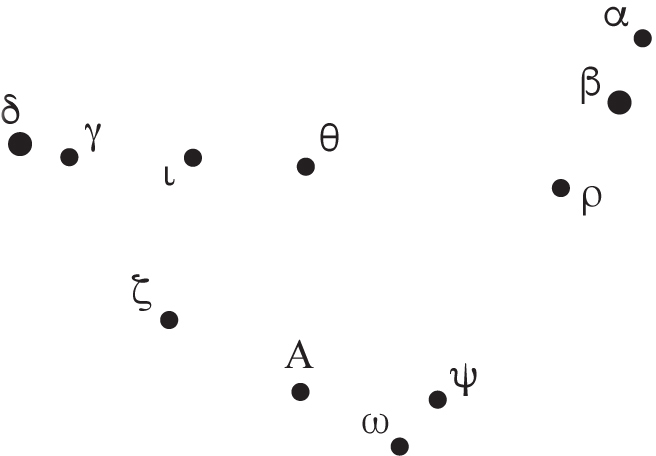
Goat Horn |
|
|
English name |
Greek name |
|
Capricornus |
|
|
Latin name |
pronunciation |
|
δ Capricorni |
21h 47m 02s |
−16° 07′ 38″ |
primary star |
right ascension |
declination |


THE ESCAPE OF APHRODITE AND EROS
Zeus and his friends and followers won the first fights with the Titans. But the conflict turned against the gods when Gaea, who is Mother Earth and mother of the Titans, brought forth her final offspring—the monster Typhon. The creature’s enormous size, earth-shattering strength, and fiery breath made him the fiercest beast to ever be unleashed. Typhon soon rumbled forth from the bowels of the earth, determined to hunt down the deities and devour them one by one. Several fled in despair, or disguised themselves as birds or fishes in order to take flight in the sky or find refuge in the sea.
The goddess Aphrodite and her son, Eros, hid in the land of Syria. There they thought themselves safely beyond his reach. But as they dawdled dreamily down the bank of the Euphrates River one day, Typhon appeared without warning, as was his way. With a deafening roar, he burst from the earth and pursued them in volcanic fury. Suddenly pinned between fire and water, Aphrodite grabbed Eros in her arms, and, in desperation, dove for the depths of the river.


Fishes |
|
|
English name |
Greek name |
|
Pisces |
|
|
Latin name |
pronunciation |
|
η Piscium |
01h 31m 29s |
+15° 20′ 45″ |
primary star |
right ascension |
declination |
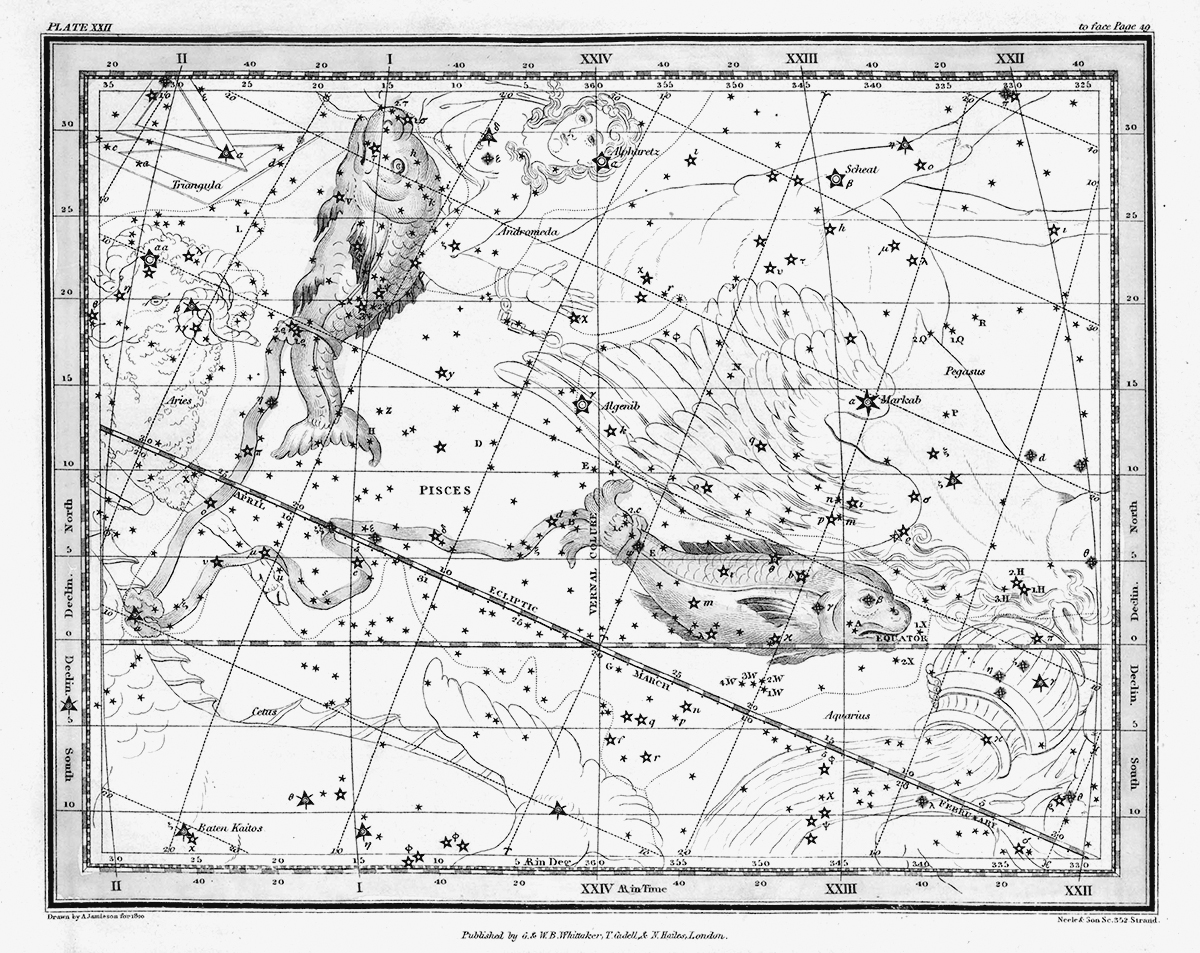
Aphrodite was born of the sea, and easily adapted herself and her son to the water. In haste, they took the form of fishes in order to breathe and swim in their new surroundings. To keep her son close by her side, she tied each end of a cord to their tails.
Fortunately for them, Typhon was a fiery fiend who despised the cold and quenching effects of river and sea. He balked at the thought of pursuing them as they darted among the slippery rocks, through tangles and snags, and swam with the current to safety. Steaming and hissing in bitter rage, he angrily abandoned the chase. A comfortable distance downstream, Aphrodite and Eros emerged from their watery refuge and dried themselves in the springtime sun and balmy breeze.
In the years that followed, Syrians who lived along the river refused to eat fish, to show their respect for the divine mother and child. Zeus, for his part, celebrated the escape of the two by designating stars to form the FISHES. High in the night sky, Aphrodite is seen as she swims the Euphrates’ flowing stream, still tied by a cord to Eros, who dashes and darts to the left.5
As a further distinction, Zeus ordained that the sun should traverse their constellation in its annual passage across the sky. Thus, every year, when the sun aligns with the Fishes, it marks the close of the cold and rainy season, and heralds the emergence of life-giving spring.

THE FISH THAT SAVED A GODDESS
In later years, another fish of the swift Euphrates gained similar fame for saving Derceto, a daughter of Aphrodite. Derceto, in honor of her mother’s escape from Typhon, had always favored the fishes of the river. At her temple in Bambyce, near the west bank of the Euphrates, she kept her favorite scaly friends in a sacred lake. Each day, she fed them as they gathered in schools and gaped above the surface.
One evening, as she leaned with food in hand far over the water, she lost her footing and slipped into the glassy lake. Quick as a flash, the largest fish flicked his fins and darted beneath her sinking form. Rising to the surface, he laid her on the bank and saved Derceto from drowning.
Aphrodite, the grateful mother, rejoiced in the rescue and recognized the valiant deed by assigning the fish a place in the cosmos. Here, he is known as the SOUTHERN FISH because of his position low in the southern sky. Like Aphrodite and Eros, he, too, is revered by the Syrians, who honor the three by fashioning delicate fish designs out of silver and gold.


Southern Fish |
|
|
English name |
Greek name |
|
Piscis Austrinus |
|
|
Latin name |
pronunciation |
|
Fomalhaut |
22h 57m 39s |
−29° 37′ 20″ |
primary star |
right ascension |
declination |
The Southern Fish received further reward by being adorned with one of the most dazzling stars in heaven. It marks his gaping mouth beneath two tiny eyes. As he swims across the celestial sphere, he opens wide to drink a draft of water poured as a pure libation by the constellation called the Water Bearer.6

POSEIDON’S LOYAL DOLPHIN
Another wanderer of the watery deep—the Dolphin—received similar celestial acclaim for his selfless service to a divine being. Poseidon, god of the sea, presided over all the dolphins and other creatures of his aquatic domain. But his powerful presence caused his minions to shudder and stay away. As a result, he remained quite lonely as he pined away in his palatial undersea cave.
At last, he declared his longing desire to marry a modest nymph named Amphitrite. The coy sea-maiden was flustered and frightened by the affections of the powerful god. Straightaway she fled far to the west, where the waters of the Mediterranean lap the shores near the Atlas Mountains.
Poseidon confided his feelings to his friend—the Dolphin—and convinced him of his genuine love for the girl. The Dolphin, fully assured of the god’s good intentions, departed with haste through the salty sea to search for Amphitrite.
High and low he looked—not in wide open waters, nor on islands where sea folks gather, but in secret coves and sunken caverns far beyond the horizon. He knew the hideouts of the deep—every crack and chasm, every cave and coral reef. Time and again, as he swam beneath the waves and leaped above the surf, he scattered schools of fishes and slipped away from menacing sharks.
After searching for many days, the Dolphin discovered Amphitrite, trembling in a tiny cave, surrounded by a small gathering of seahorses and starfishes, her only friends. With gentle words of encouragement, he assured the nymph of her suitor’s love and convinced her to wed the watery god. Upon their long-awaited return, he presented the timid bride to Poseidon. The Dolphin then presided over the nuptials before a beaming, bubbling audience—a colorful array of the creatures of the sea.


Dolphin |
|
|
English name |
Greek name |
|
Delphinus |
|
|
Latin name |
pronunciation |
|
β Delphini |
20h 37m 33s |
+14° 35′ 42″ |
primary star |
right ascension |
declination |
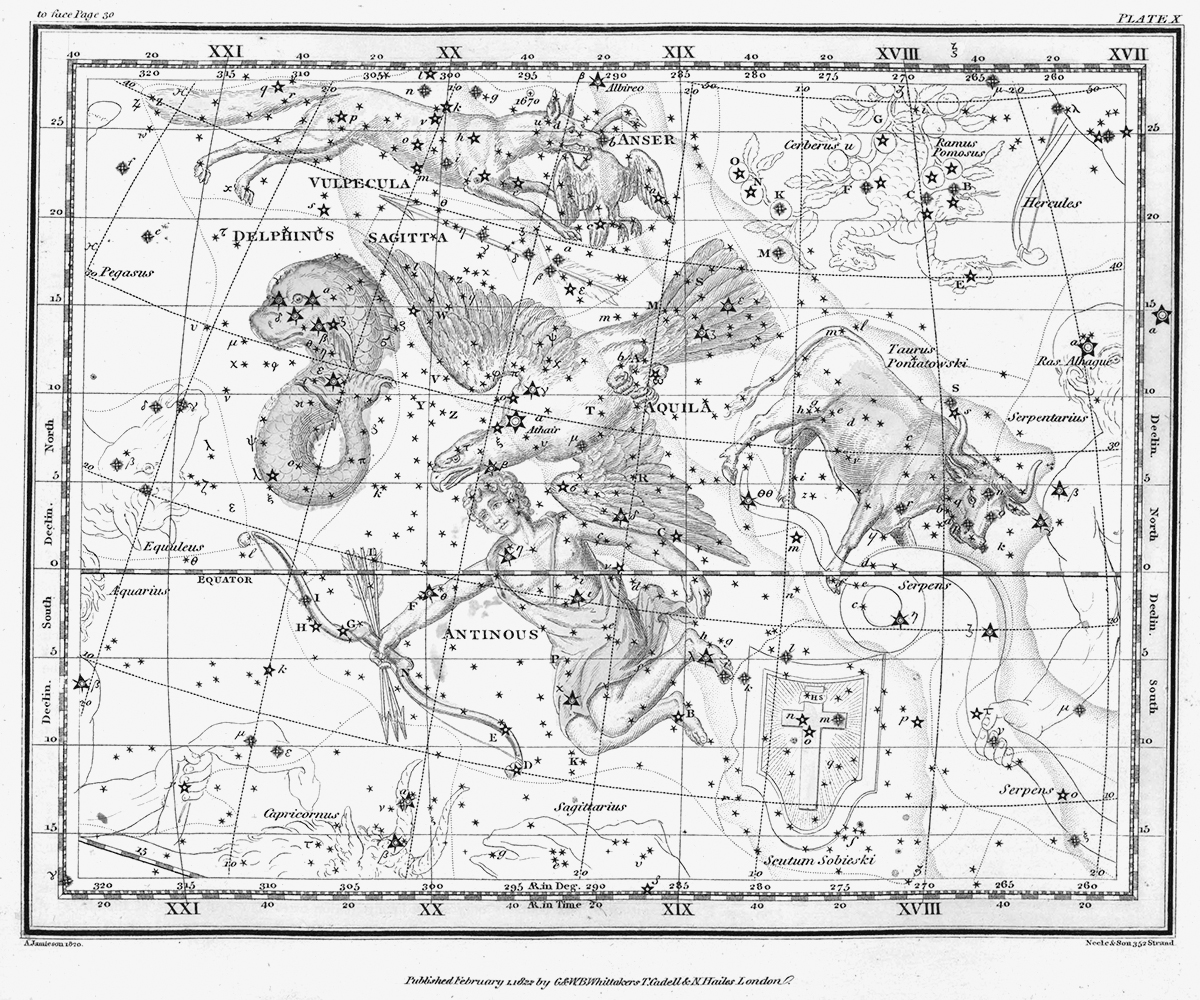
On countless other occasions, the Dolphin and his kinsmen served humans equally well by guiding ships and saving floundering seamen. Even the Argonauts fondly recalled how “dolphins in calm weather leap up from the sea and circle a ship in schools as it speeds along, sometimes showing up in front, sometimes behind, sometimes alongside, and joy comes to the sailors.”7
For his service to Poseidon, and all of mankind, the DOLPHIN earned an eternal home in the stars. There he leaps with elation and offers a sign of assurance at night for navigators traveling on the trackless sea.

THE MIGHTY EAGLE OF ZEUS
Mortal men, like Erechtheus, and beasts of the earth, like Amalthea, the Kids, Aegoceros, and the Donkeys, faithfully served the divine deities. The Syrians, too, revered Aphrodite and Eros as the Fishes. And watery creatures, like the Southern Fish and the Dolphin, aided and honored the gods.
In the same way, the birds of the air displayed their devotion on many occasions. In fact, all the deities have their favorite birds that faithfully serve them. The little owl is Athena’s constant companion, as shown on the silver drachmas of the Athenians. Zeus’s winged friend is the mighty Eagle.
As Zeus’s campaign continued against the Titans, the war clouds gathered. Lightning flashed in the stormy sky and rumbled in echoes of thunder. Beneath the terrible tempest, Zeus prepared his anxious army for battle. As he attempted to quell their fears and prompted them to perform valiant deeds, an enormous Eagle suddenly appeared. Like a rush of wind, the majestic bird alighted by Zeus’s right side.

A spirited shout resounded through the ranks as the soldiers witnessed this favorable omen. Their hearts now swelled with courage, and they bolted forth to scatter the Titan foe. As they hammered swords against shields, clinking and clanging in wrathful rage, the Eagle circled high above, offering inspiration.
At the end of the day, with the battle won, the Eagle returned to the god of sky and storm. Zeus raised the raptor high above his head, perched on his upraised fist, and declared him his friend from that day forward.
In ages to come, the Eagle often proved his allegiance and favored Zeus with offerings of esteem. When Zeus demanded a cupbearer—a person of grandeur and grace worthy to bear libations to the gods, the Eagle brought him Ganymede—“the fairest of mortal men.”8 To the heights of Olympus he carried the youth, carefully cradled in his massive claws.
For this thoughtful deed, and to praise all of his kind, Zeus immortalized the EAGLE, allowing him to soar in the nighttime sky—in splendor for all to see. His breast is turned toward the Earth and he bears a bright star on his shoulders. Three neighboring astral lights mark the beak and upper wings and two appear on the tail. Tenderly clutched in his talons, six stars glow in the form of glorious Ganymede.9

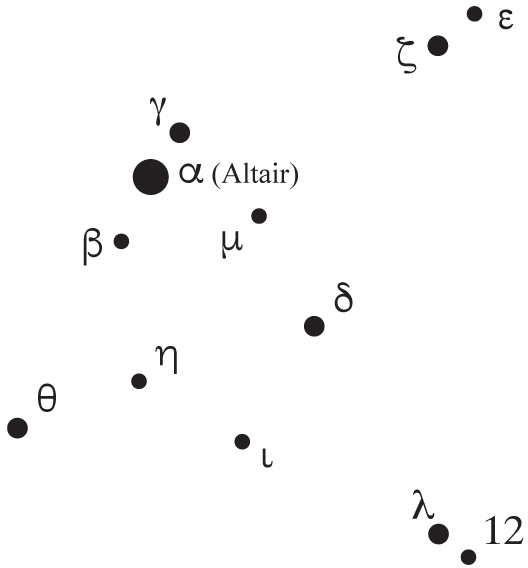
Eagle |
|
|
English name |
Greek name |
|
Aquila |
|
|
Latin name |
pronunciation |
|
Altair |
19h 50m 47s |
+08° 52′ 06″ |
primary star |
right ascension |
declination |


Water Bearer |
|
|
English name |
Greek name |
|
|
|
|
Aquarius |
|
|
Latin name |
pronunciation |
|
β Aquarii |
21h 31m 34s |
–05° 34′ 16″ |
primary star |
right ascension |
declination |
For his part, Ganymede, the son of King Tros—the eponymous founder of Troy—also appears in his own constellation because of his steadfast service to the gods. Here he is known to the ages as the WATER BEARER. Every night, from his right hand he pours a sparkling libation marked by a shimmering stream of stars.

THE ALTAR OF HEAVEN
The campaign against Cronos and the Titans dragged into months, and months turned into years, but the war only worsened. Heaven and Earth quaked in fury, the seas slammed fiercely against the shores, and all of nature trembled.
To keep the army together in trying times, Zeus and the gods often affirmed their allegiance to one another by offering fragrant herbs on a sacred Incense Altar. In radiant robes they assembled, and in solemn procession they bore their blazing torches. One by one, they laid them on the altar’s burning brazier, and swore undying devotion to their cause.
Thus armed—with fervor forged by oneness of mind—they sallied forth to destroy the foe. At last, ten tragic years of warfare ended. In dismal defeat, Cronos and the Titans descended into the dungeon of Tarturus, in the depths of the Earth.
That night, on the summit of shining Olympus the deities delighted in triumph. Nike—the goddess of victory—resplendent in starlight, blessed the moment by pouring pure libations. Then, Zeus placed the INCENSE ALTAR, with its rounded brazier and flying sparks, as a memorial in the sky. There it glows as a reminder to immortals and mortals alike of the strength of sacred devotion.10 Now, all who see it in the sky are inspired to erect altars in holy places and pray for success in worthy endeavors. Now they affirm allegiances with “incense and reverent vows, and libations, and the savor of sacrifice.”11

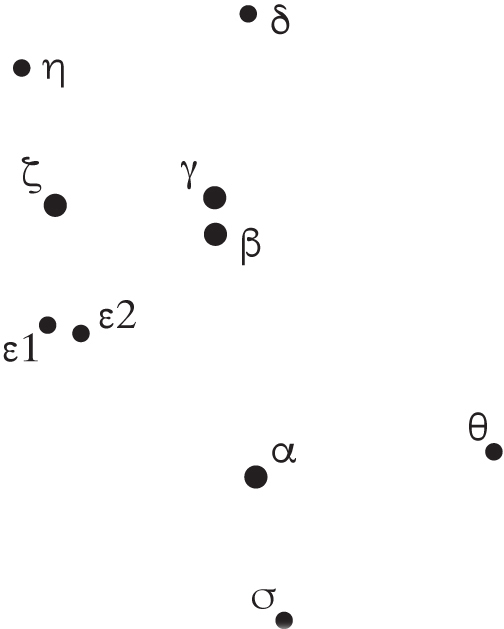
Incense Altar |
|
|
English name |
Greek name |
|
Ara |
|
|
Latin name |
pronunciation |
|
β Arae |
17h 25m 18s |
−55° 31′ 48″ |
primary star |
right ascension |
declination |
















